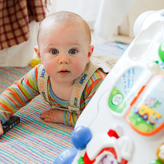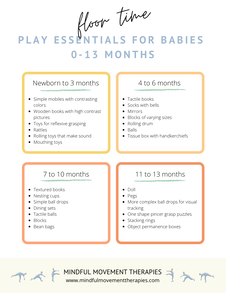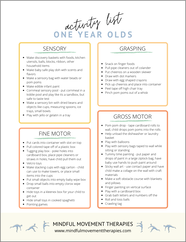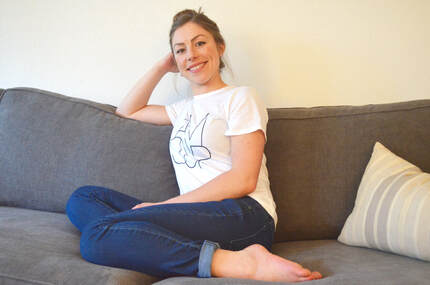A baby learns so rapidly that within 12 short months, we watch our little humans go from complete dependency, to becoming mobile. To give you an idea of why the transformation happens so fast, we know that from birth to age 3, about 80% of the brain is developed. And by age five, 90% of the brain is developed. So, no pressure, but we have a short window of opportunity to get a few things right, that will set the foundation for long term physical development, emotional health, and cognitive learning. One of those key things is quality movement exploration on the floor.
Here's why. Babies are naturally curious and intrinsically motivated learners. Floor time provides them the opportunity to move according to their own inherent abilities on their own timetable, which is what drives development forward. If you watch a newborn, they twitch, wiggle, and move randomly. Those reflexive and random movements collect and send a flow of sensory information to the brain that helps map the body. Sensations like the feeling of the blanket on her skin, the pressure of her head, neck, or back on the floor, and information from the muscles and joints of her limbs as they move in the air. Exploring and experimenting with those jerky and abrupt random movements is what leads to controlled, functional, and intentional actions like stretching, twisting, rolling, creeping, sitting, crawling, standing, and walking. A child who is given lots of time on the floor to develop these skills will instinctively gain the muscle strength, flexibility, balance, body awareness, and coordination it takes to master each next milestone. If a baby does not get opportunities for quality movement experiences early on, they may face developmental and lifelong learning challenges, and see a pediatric therapist like me. So, it is super important for your child to get lots of free play time on the floor. Why the floor, and not in a lounge seat, carseat, DockATot, Bumbo seat, or other piece of equipment? Use of baby "containers" restricts movement, limiting an infant's ability to move randomly and freely. Time spent strapped into these things is time not spent optimizing a child's earliest opportunities to move and explore on their own. The floor offers the most space and the most choice for self-directed learning. Here are a few ways to provide floor time in a way that fosters your child's learning and development. Start with your baby lying on her back. In this position, your baby has space around her and in front of her to move and wiggle, and she can see much of the room. If she wants to change her position, she can when she is able to. Choose a hard non-slip surface like carpet, a mat, or a blanket. This provides clear sensory input and does not restrict range of motion that a cushion or lounge seat would. Play in the grass! Have wiggle time outside in the fresh air, so your baby can explore and experience all the sensory input from the world outside. Keep in mind what clothing your child is wearing during free play and movement time. Comfortable outfits that allow for movement and flexibility are most helpful. Create plenty of wiggle-friendly rooms and “yes” spaces in your house or outside, childproofing as necessary. That way you can sit back and let your little one move and explore freely as she grows and becomes more mobile, without worrying or having to discourage her curiosity in any way. Try not to interfere or "teach" anything. Allow your infant to learn to move and do things independently, through patience and persistence. I recommend not propping your baby up or placing her in a position she cannot get into herself. Trusting your infant to do what she is ready to do will boost her confidence and independence tenfold. Opt for simple uncomplicated toys instead of overstimulating battery operated toys. Choose toys that offer a variety of contrasting colors, textures, weights, sizes, and sounds. Place them close to your child on the floor and allow your child to decide what to do with them and how to get to them.
Provide a calming and nurturing atmosphere that respects your baby. Place her on the floor gently, remain calm in how you interact and play with your child, and contain your enthusiasm. The moment we cheer, celebrate a milestone happening, or ask a baby to do it again, we make it about ourselves and our expectations.
Tune into your baby's cues and respect them. Signs that your baby is ready for floor time include being animated, vocal, active, smiling, curious. Signs it may be time for a break include your baby turning her head away and averting eyes, rubbing eyes, getting fussy, etc. The best time for movement and play is typically after a nap and a meal. But, be mindful of the potential for reflux after meals. If you think your baby may experience this, wait for 10-15 minutes before placing her on her back on the floor. Here is the bottom line.
Do you have a child who is over 13 months? This can be kind of an awkward phase, because your child is not quite a baby, but not quite a toddler! He/she is a "taby" (a termed I love by Busy Toddler). I have some fun things you can do with your mobile and curious little one. Check them out below.
0 Comments
Your comment will be posted after it is approved.
Leave a Reply. |
meet the bloggerAusten is a pediatric occupational therapist with experience in schools, early intervention, and private clinic settings. She now runs her own private practice in Portland, OR specializing in movement based learning techniques. This blog's mission is to educate and empower parents and children by sharing insights into the complexities of learning and development. Categories
All
|
MINDFUL MOVEMENT THERAPIES
In-Home Pediatric Occupational Therapy in Portland, Oregon
phone503-720-4634
|
austen@mindfulmovementtherapies.com
|
|




